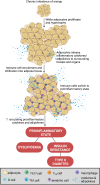Sex hormones, intestinal inflammation, and the gut microbiome: Major influencers of the sexual dimorphisms in obesity
- PMID: 36248832
- PMCID: PMC9554749
- DOI: 10.3389/fimmu.2022.971048
Sex hormones, intestinal inflammation, and the gut microbiome: Major influencers of the sexual dimorphisms in obesity
Abstract
Obesity is defined as the excessive accumulation of body fat and is associated with an increased risk of developing major health problems such as cardiovascular disease, diabetes and stroke. There are clear sexual dimorphisms in the epidemiology, pathophysiology and sequelae of obesity and its accompanying metabolic disorders, with females often better protected compared to males. This protection has predominantly been attributed to the female sex hormone estrogen and differences in fat distribution. More recently, the sexual dimorphisms of obesity have also been attributed to the differences in the composition and function of the gut microbiota, and the intestinal immune system. This review will comprehensively summarize the pre-clinical and clinical evidence for these sexual dimorphisms and discuss the interplay between sex hormones, intestinal inflammation and the gut microbiome in obesity. Major gaps and limitations of this rapidly growing area of research will also be highlighted in this review.
Keywords: estrogen (17β-estradiol); gut microbiota; leukocytes; obesity; testosterone.
Copyright © 2022 Brettle, Tran, Drummond, Franks, Petrovski, Vinh and Jelinic.
Conflict of interest statement
The authors declare that the research was conducted in the absence of any commercial or financial relationships that could be construed as a potential conflict of interest.
Figures




Similar articles
-
Gut microbiota steroid sexual dimorphism and its impact on gonadal steroids: influences of obesity and menopausal status.Microbiome. 2020 Sep 20;8(1):136. doi: 10.1186/s40168-020-00913-x. Microbiome. 2020. PMID: 32951609 Free PMC article.
-
Sexual dimorphism of cardiometabolic dysfunction: Gut microbiome in the play?Mol Metab. 2018 Sep;15:70-81. doi: 10.1016/j.molmet.2018.05.016. Epub 2018 May 30. Mol Metab. 2018. PMID: 29887245 Free PMC article. Review.
-
Interaction between gut microbiota and sex hormones and their relation to sexual dimorphism in metabolic diseases.Biol Sex Differ. 2023 Feb 7;14(1):4. doi: 10.1186/s13293-023-00490-2. Biol Sex Differ. 2023. PMID: 36750874 Free PMC article. Review.
-
Sex differences in colorectal cancer: with a focus on sex hormone-gut microbiome axis.Cell Commun Signal. 2024 Mar 7;22(1):167. doi: 10.1186/s12964-024-01549-2. Cell Commun Signal. 2024. PMID: 38454453 Free PMC article. Review.
-
Estrogen-mediated gut microbiome alterations influence sexual dimorphism in metabolic syndrome in mice.Microbiome. 2018 Nov 13;6(1):205. doi: 10.1186/s40168-018-0587-0. Microbiome. 2018. PMID: 30424806 Free PMC article.
Cited by
-
Gender Differences in the Interplay between Vitamin D and Microbiota in Allergic and Autoimmune Diseases.Biomedicines. 2024 May 7;12(5):1023. doi: 10.3390/biomedicines12051023. Biomedicines. 2024. PMID: 38790985 Free PMC article. Review.
-
Gut microbiota has the potential to improve health of menopausal women by regulating estrogen.Front Endocrinol (Lausanne). 2025 Jun 9;16:1562332. doi: 10.3389/fendo.2025.1562332. eCollection 2025. Front Endocrinol (Lausanne). 2025. PMID: 40551890 Free PMC article. Review.
-
Bifidobacterium's Influential Role in the Battle Against Obesity: Going Beyond Probiotics.Probiotics Antimicrob Proteins. 2025 Jul 11. doi: 10.1007/s12602-025-10645-9. Online ahead of print. Probiotics Antimicrob Proteins. 2025. PMID: 40643865 Review.
-
Association between weight-adjusted-waist index and gallstones: an analysis of the National Health and Nutrition Examination Survey.BMC Gastroenterol. 2024 Jan 18;24(1):40. doi: 10.1186/s12876-024-03127-9. BMC Gastroenterol. 2024. PMID: 38238700 Free PMC article.
-
The Gut Microbiota and Diabetes: Research, Translation, and Clinical Applications-2023 Diabetes, Diabetes Care, and Diabetologia Expert Forum.Diabetes. 2024 Sep 1;73(9):1391-1410. doi: 10.2337/dbi24-0028. Diabetes. 2024. PMID: 38912690 Free PMC article. Review.
References
-
- World Health Organization . Overweight and Obesity. (2021). Available at: https://www.who.int/news-room/fact-sheets/detail/obesity-and-overweight
Publication types
MeSH terms
Substances
LinkOut - more resources
Full Text Sources

